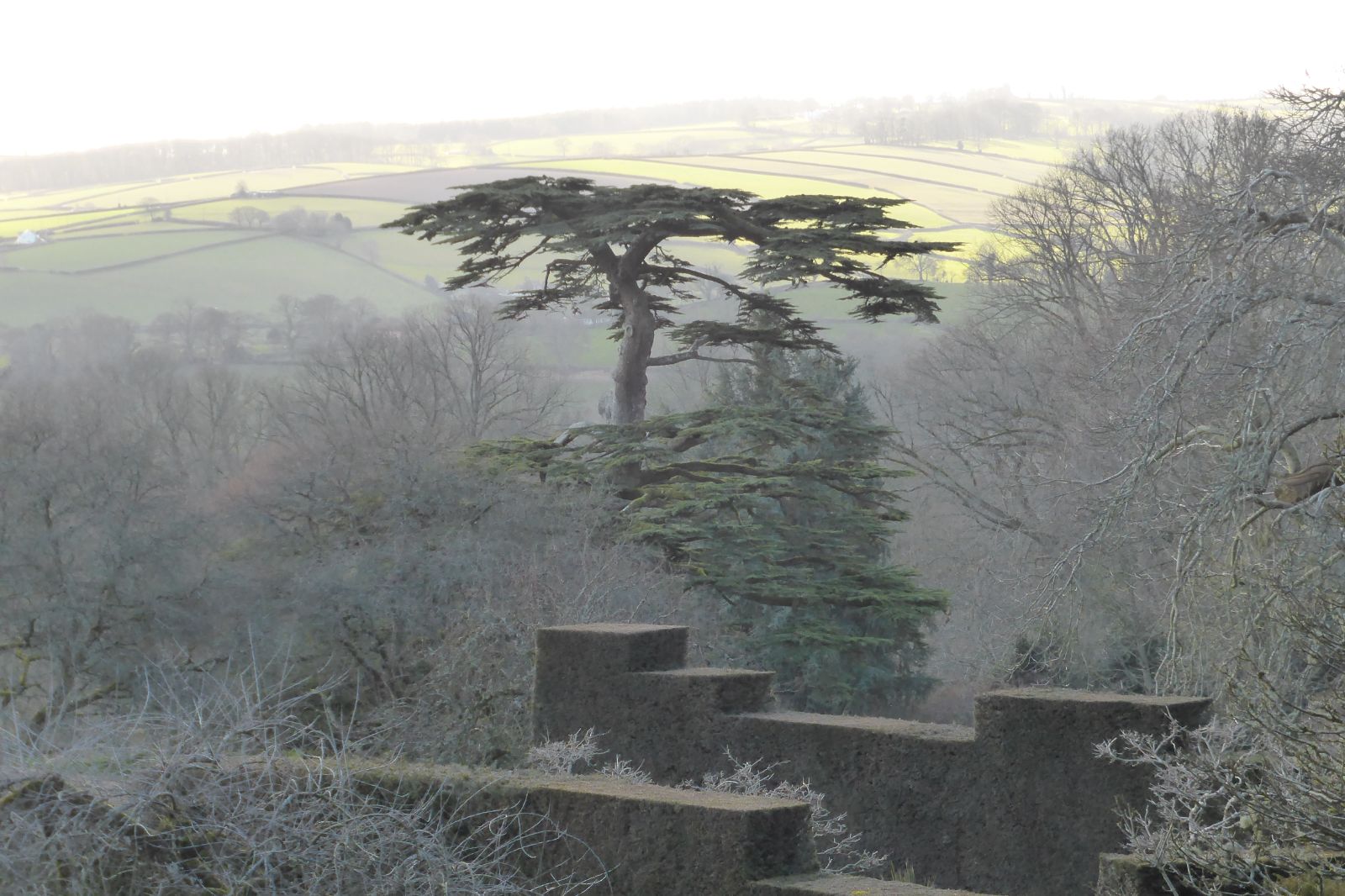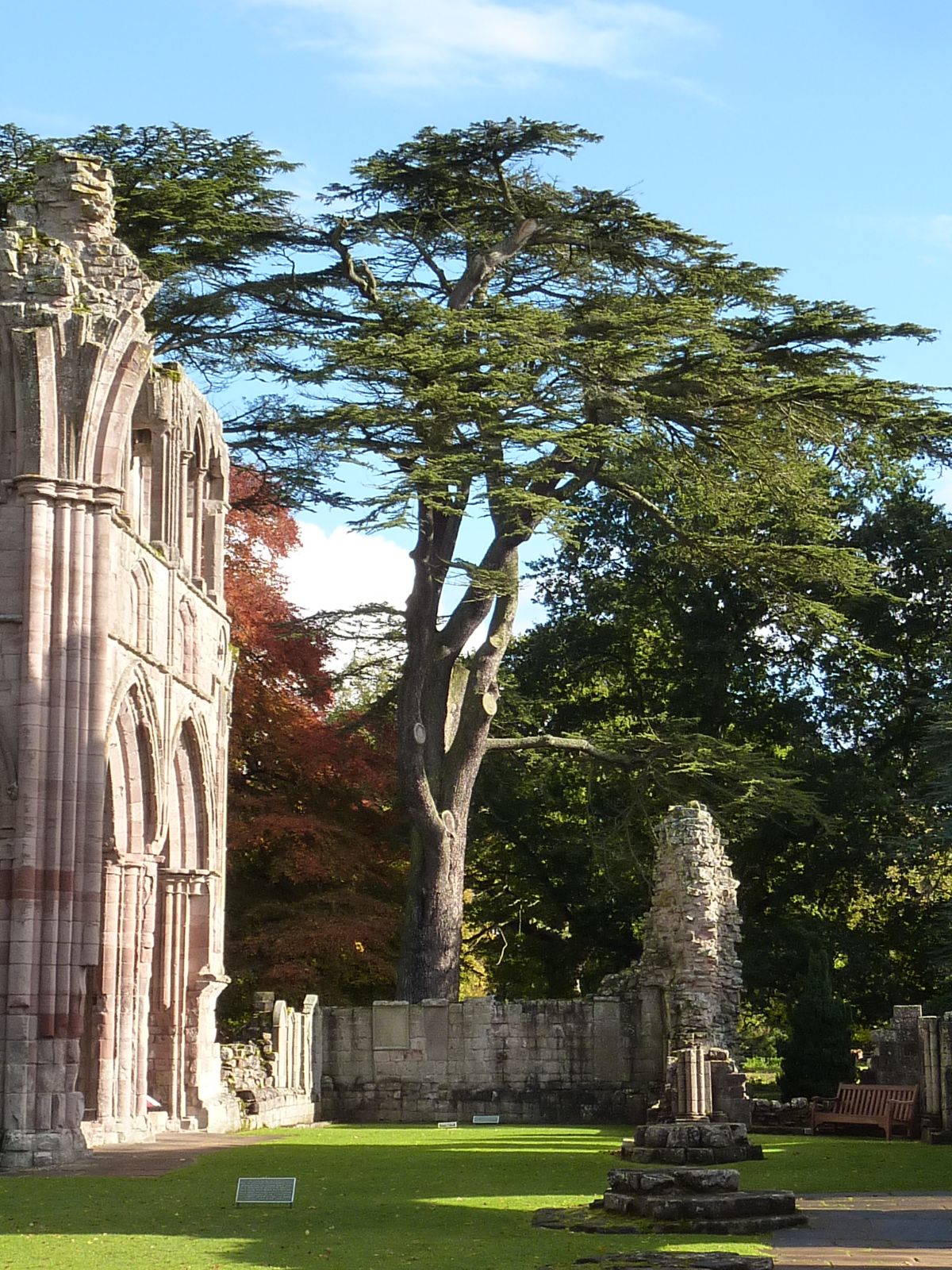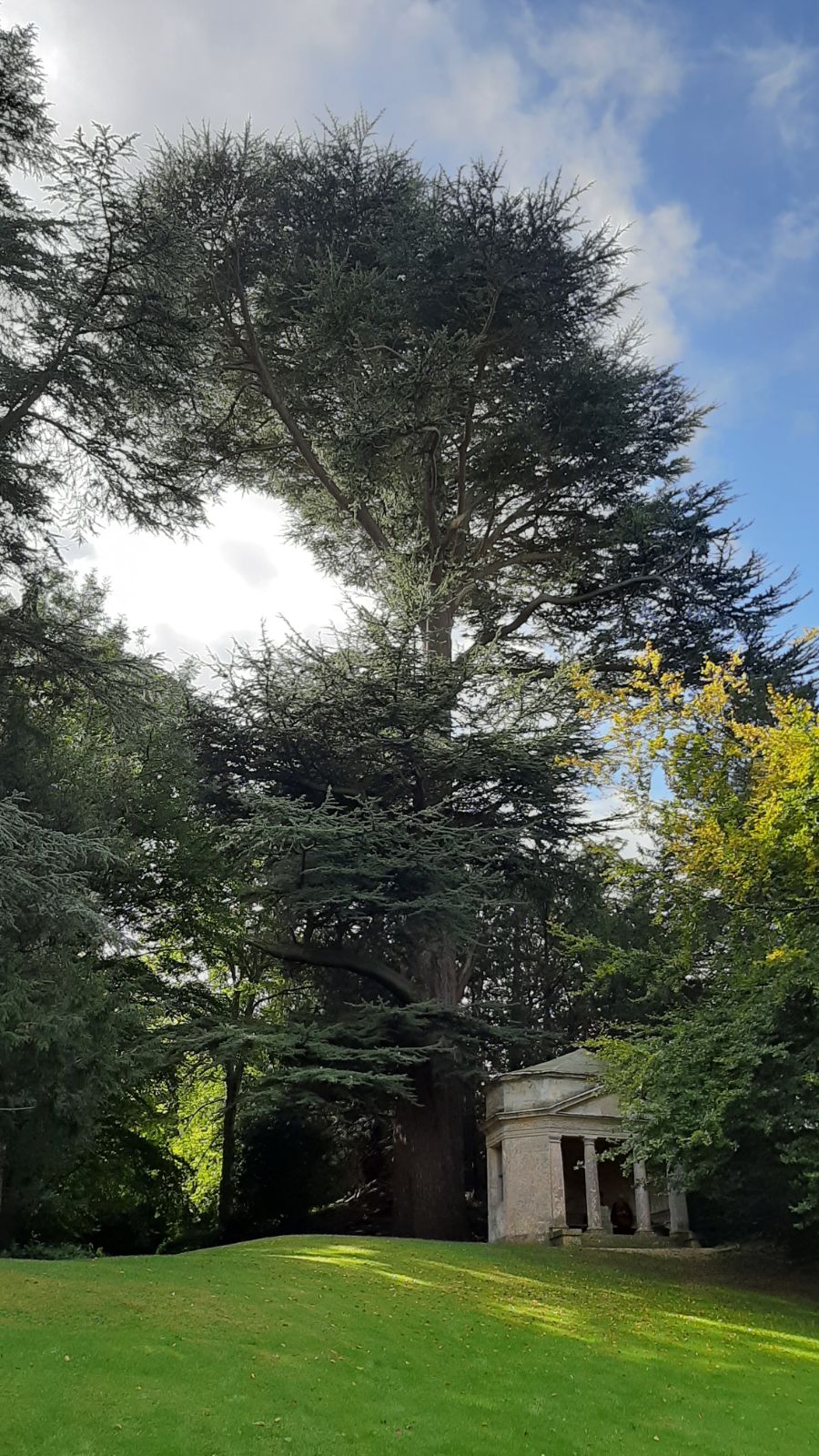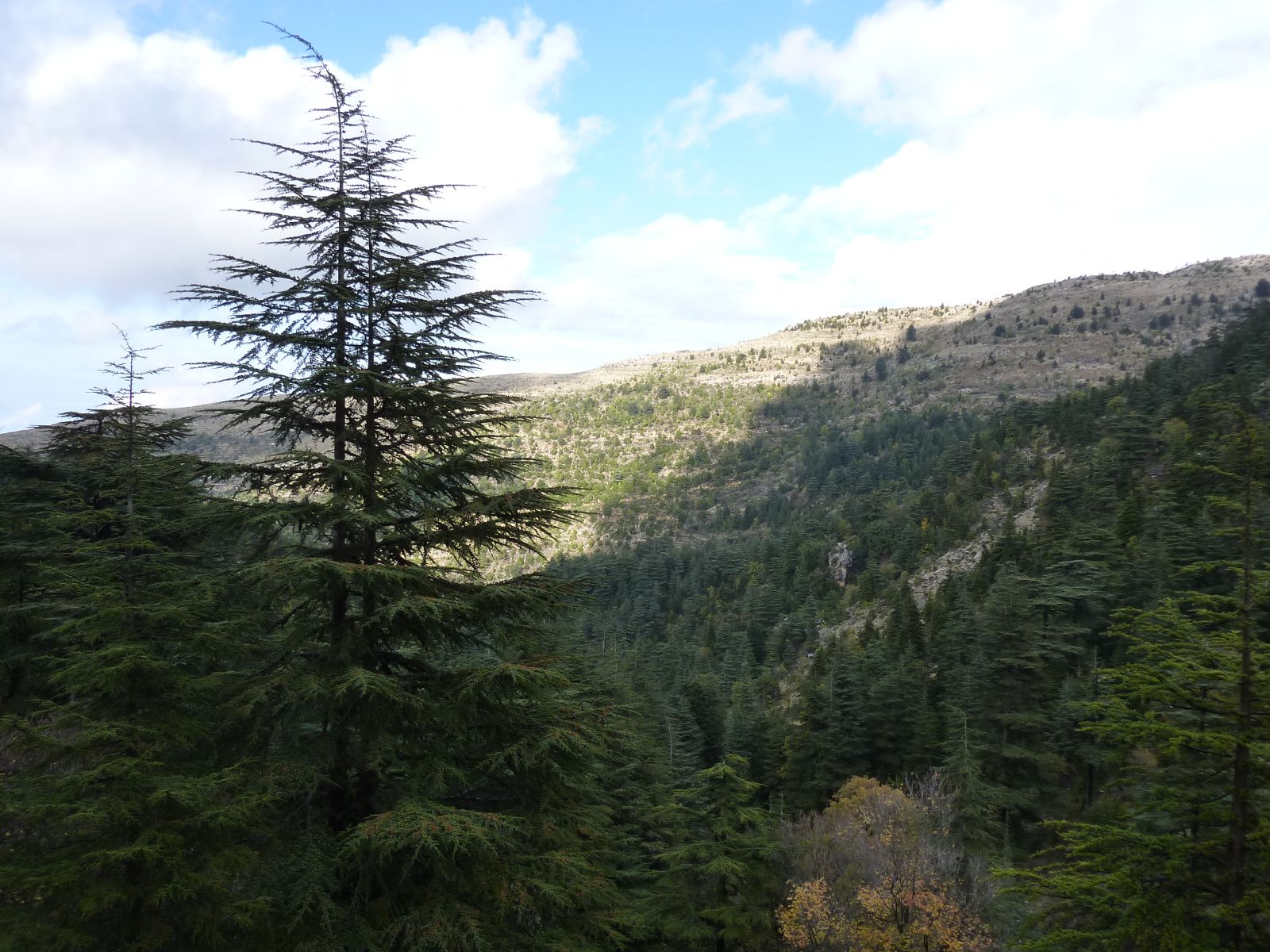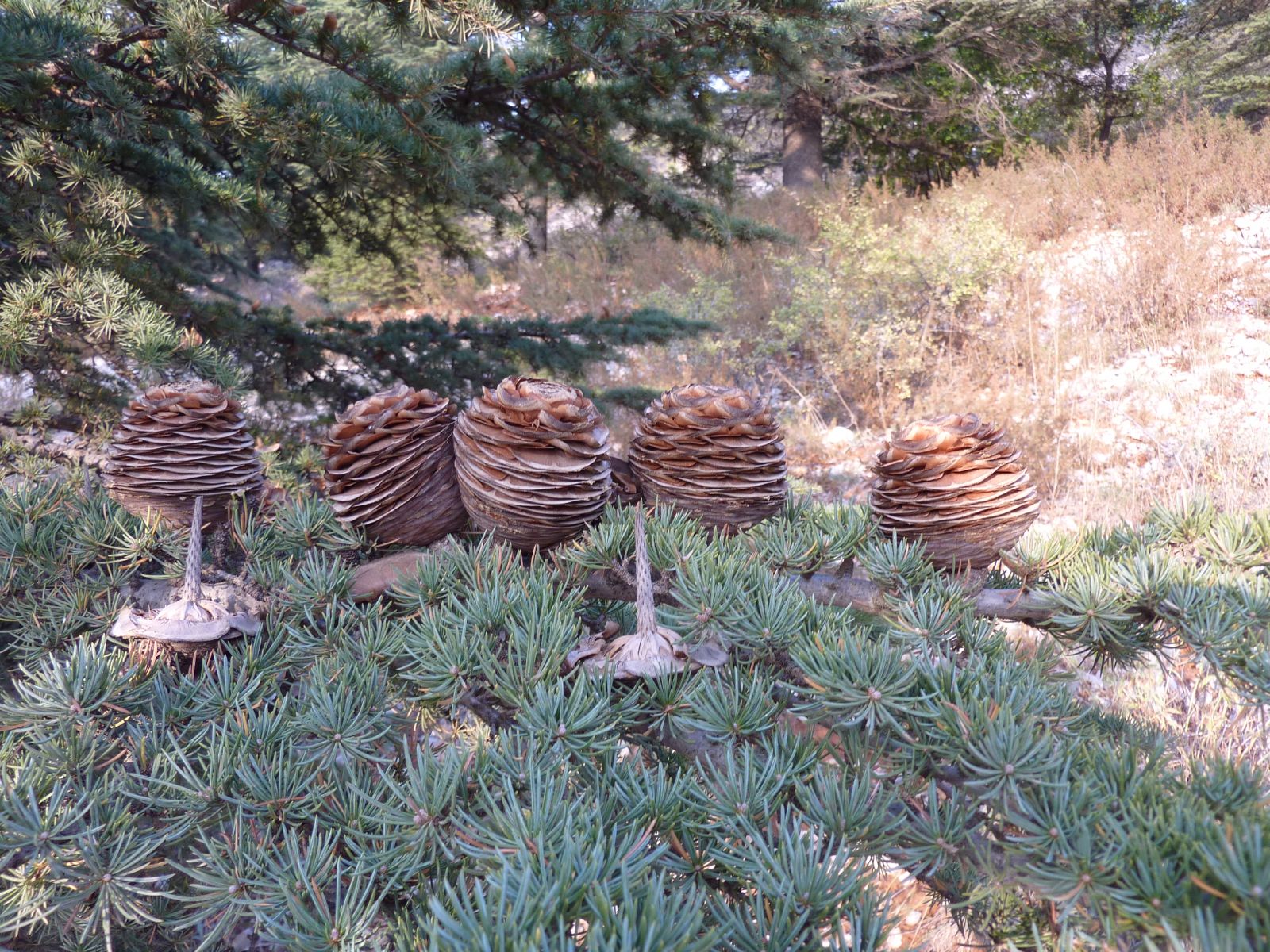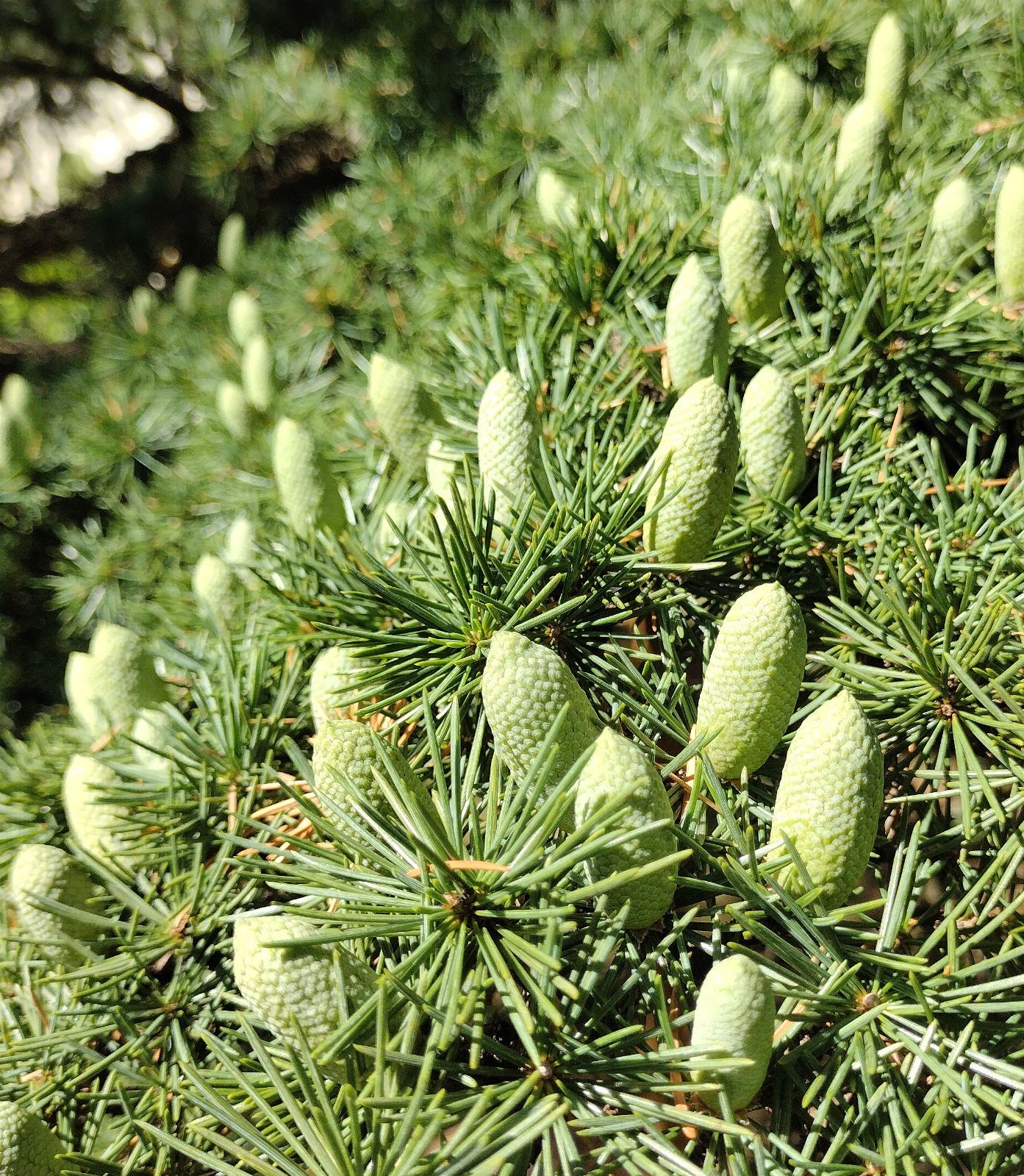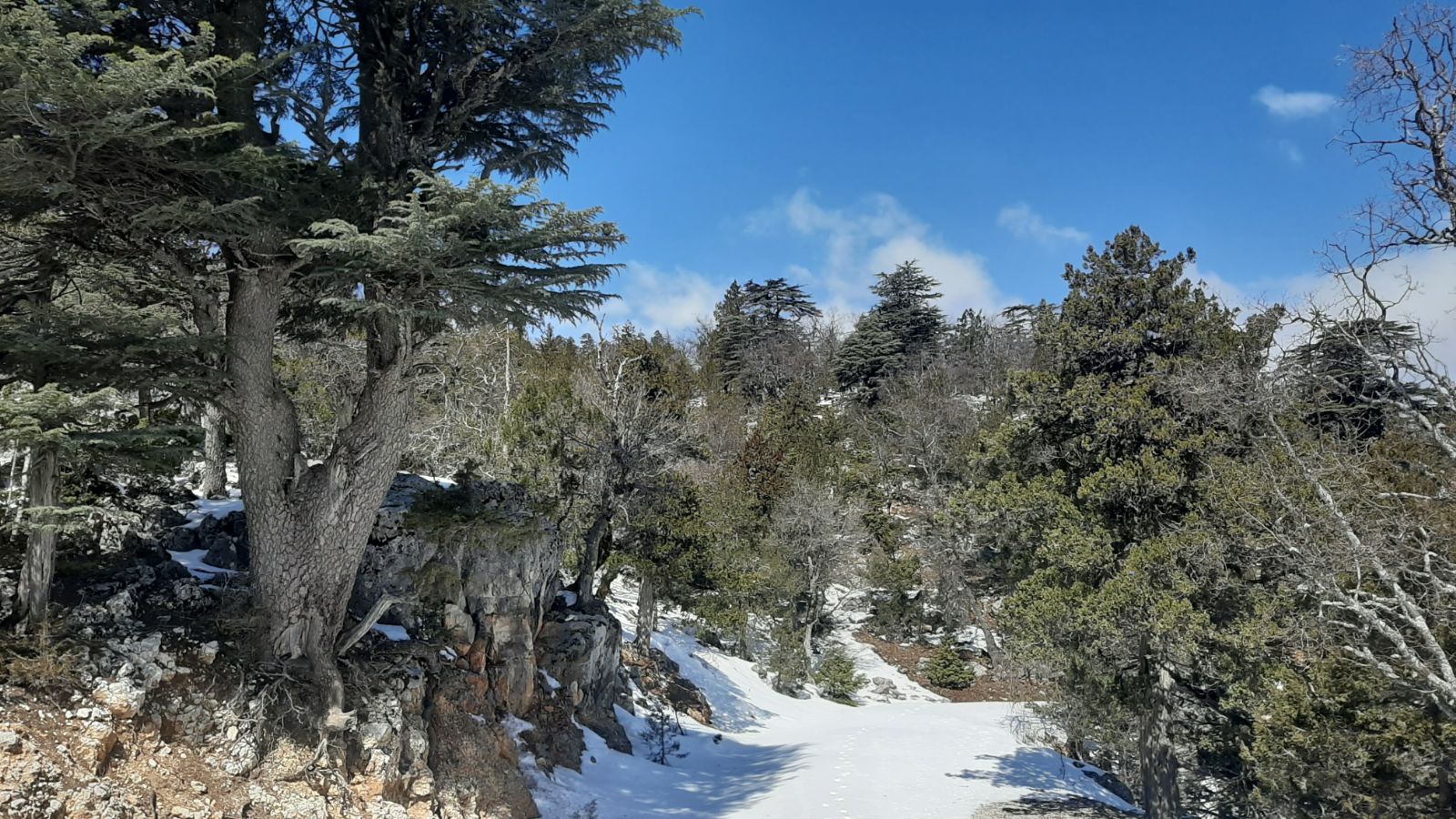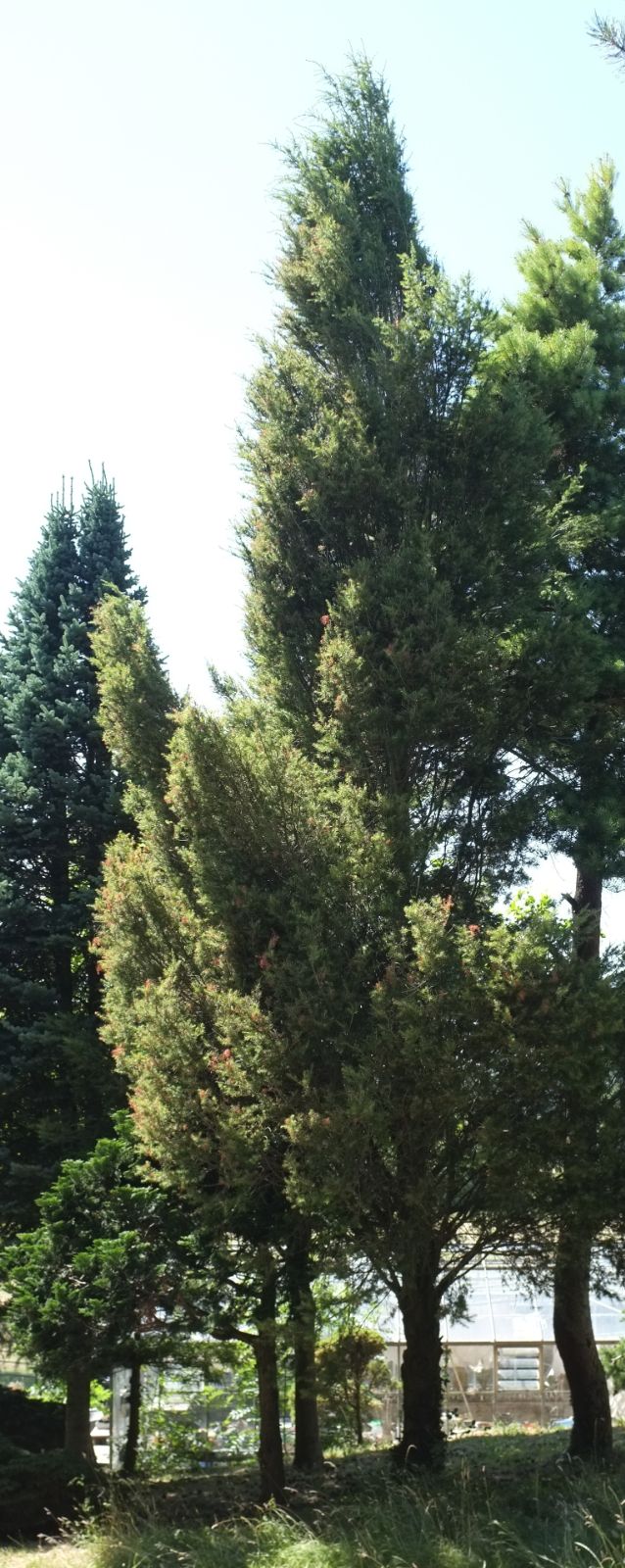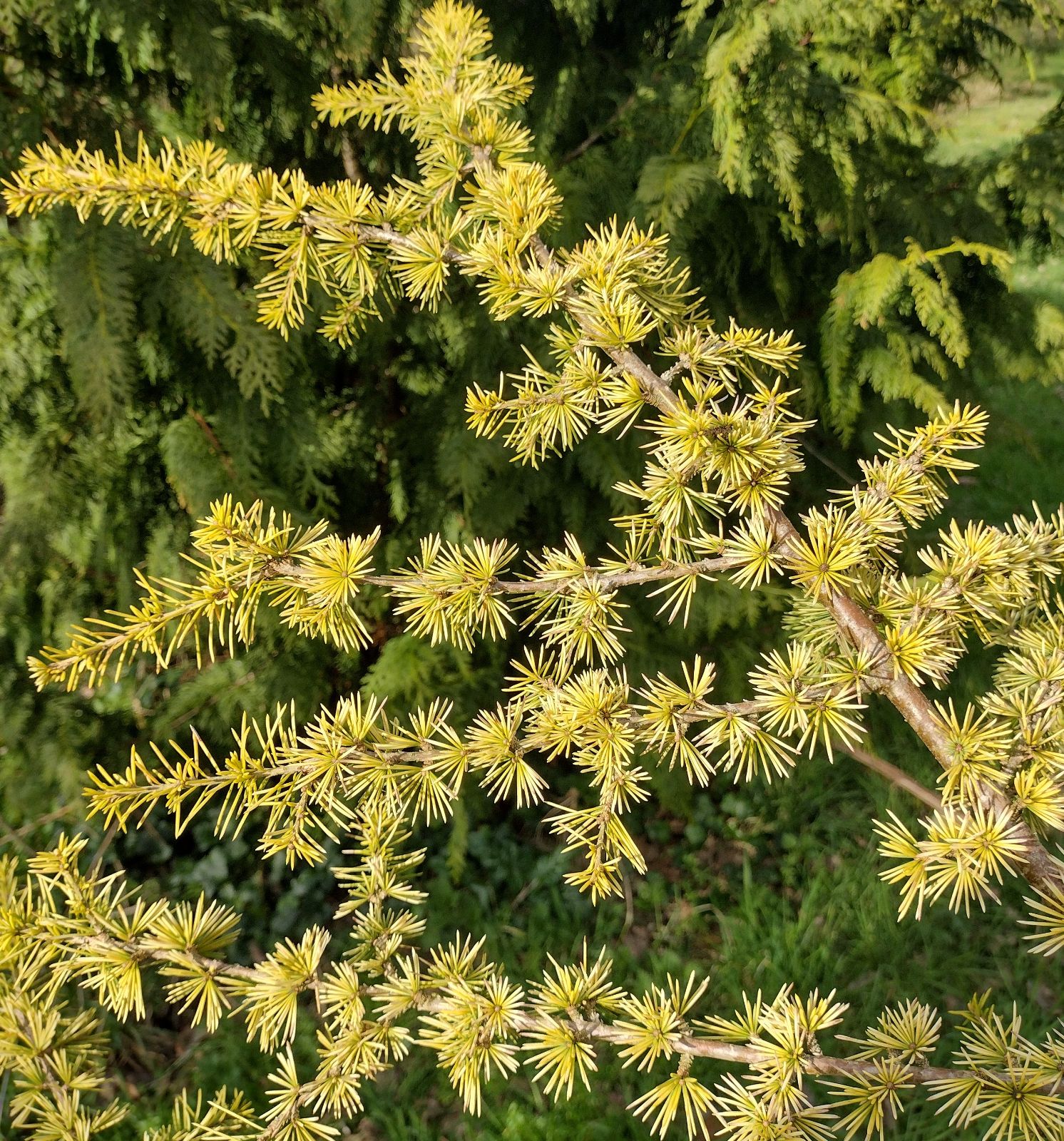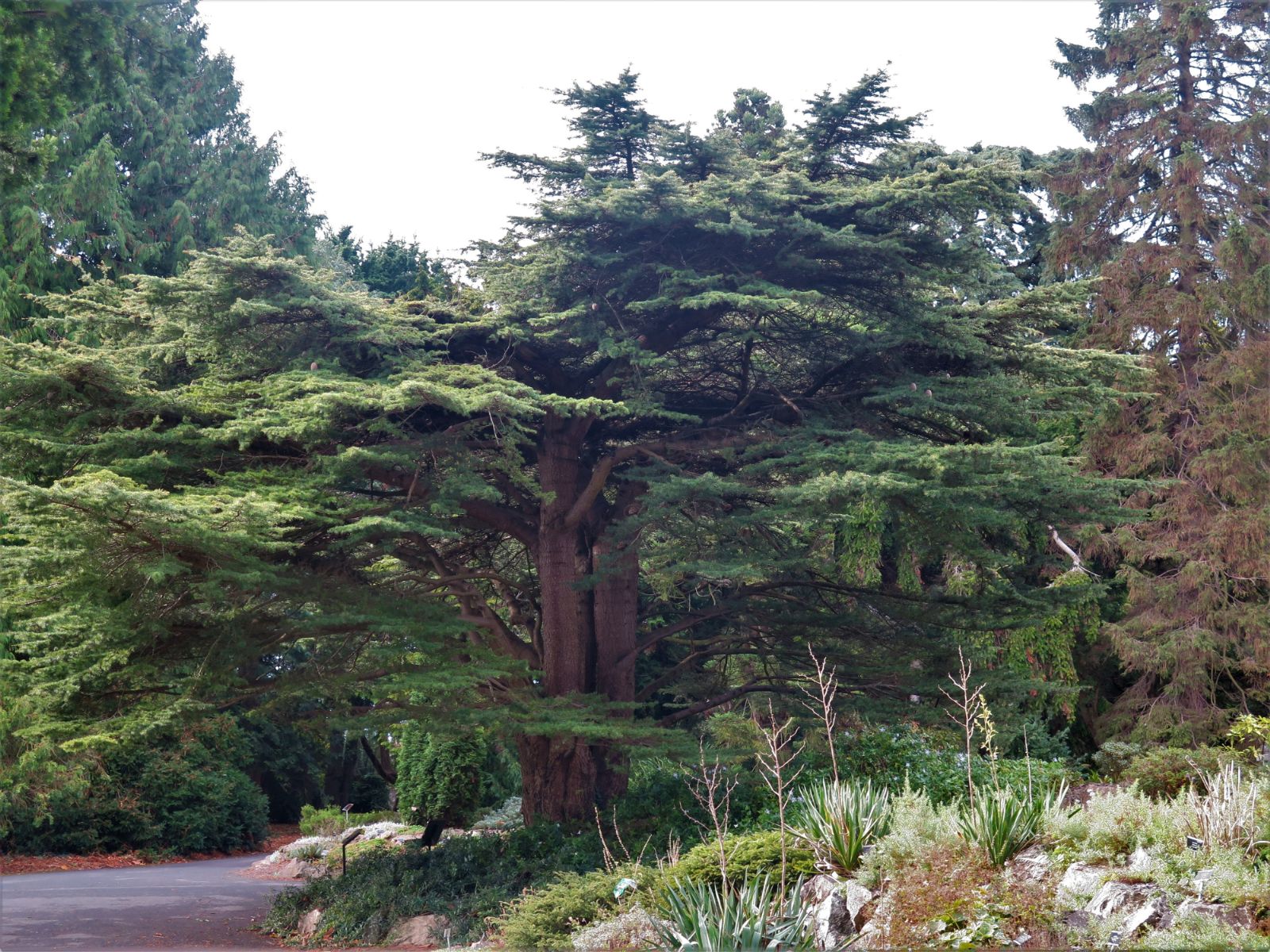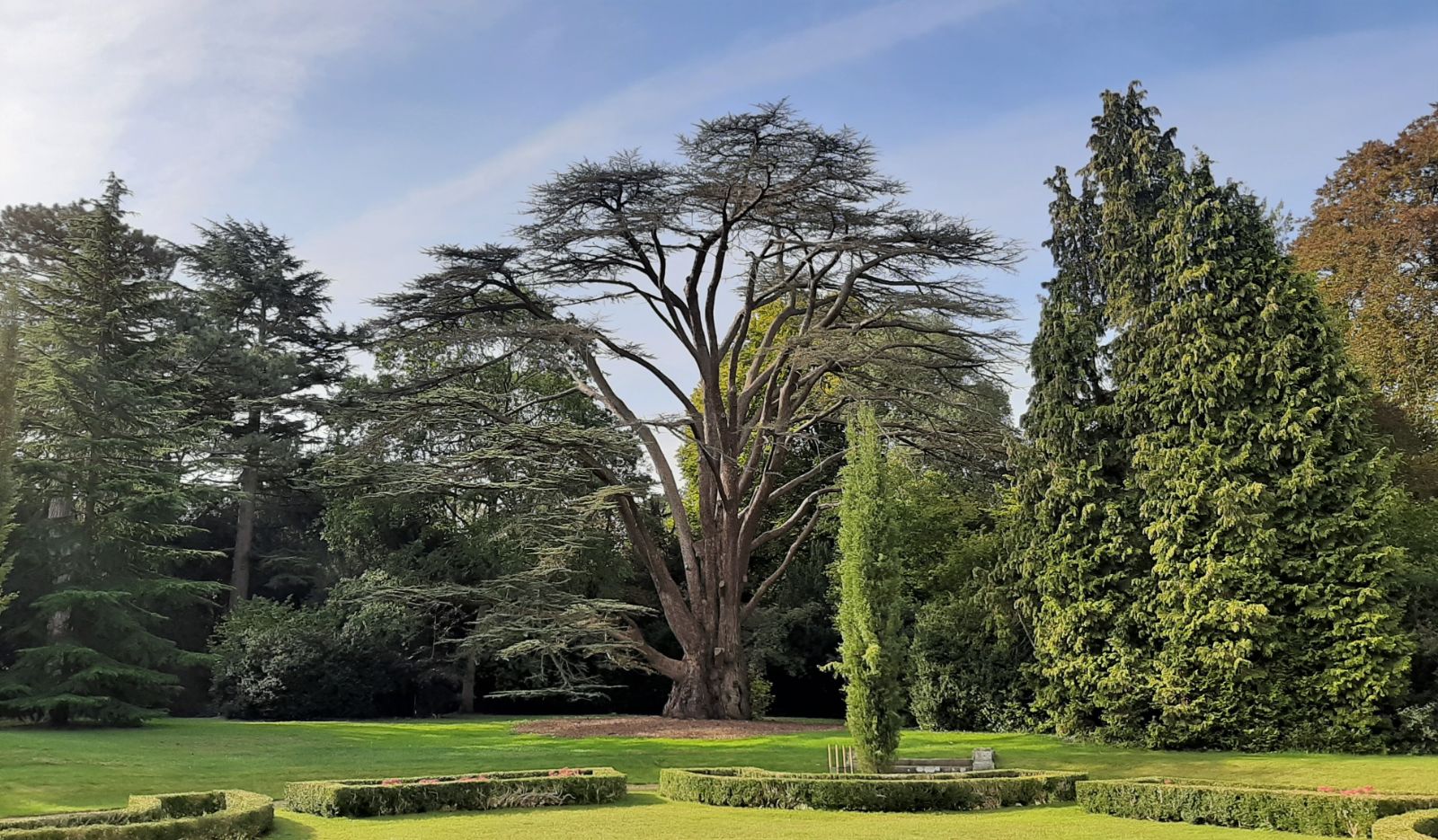Cedrus libani
Sponsor
Kindly sponsored by
a member of the International Dendrology Society
Credits
Tom Christian (2020)
Recommended citation
Christian, T. (2020), 'Cedrus libani' from the website Trees and Shrubs Online (treesandshrubsonline.
Genus
Common Names
- Cedar of Lebanon
- Lebanon Cedar
- Cèdre du Liban
Synonyms
- Cedrus libanitica Trew ex. Pilg (a pre-Linnean name)
Infraspecifics
- 'Aurea'
- 'Beacon Hill'
- 'Blue Angel'
- 'Comte de Dijon'
- 'Decidua'
- 'Denudata'
- 'Eugene'
- 'Glauca'
- 'Gold Tip'
- 'Golden Dwarf'
- 'Green Knight'
- 'Green Prince'
- 'Hedgehog'
- 'Heemstede'
- 'Home Park'
- 'Hulsdonk'
- 'Katere'
- 'May'
- 'Multicaulis'
- 'Nana'
- 'Pendula'
- 'Purdue Hardy'
- 'Sargentii'
- 'Stricta'
- subsp. stenocoma
- subsp. stenocoma 'Taurus'
- 'Tortuosa'
- 'Turkish Delight'
- 'Wells Roman Gold'
Other taxa in genus
Tree to 40 m tall, to 2.5 m dbh, usually wider than tall in maturity. Trunk usually monopodial, terete, or densely branched or forked from low down with multiple codominant trunks. Primary branches massive, borne horizontally or slightly ascendant initially, soon spreading horizontally or nearly so, sometimes depressed toward their ends on old trees, secondary branches later in horizontal planes. Crown broad-conical in young trees, later pyramidal in forest settings, or in isolated trees spreading horizontally and becoming flat topped. Bark of young trees grey, smooth, soon cracking into small dark-grey plates with cinnamon-brown new growth in fissures, on old trees rough, with deep longitudinal fissures, dark grey-brown to blackish-brown, detaching in thick plates. Branchlets of two types: short (older growth) and long (young extension growth): short shoots stout, glabrous or sparsely pubescent, assurgent or erect, brown turning; long shoots slender, shallowly grooved, pale brown, soon turning grey, initially with a dark brown pubescence. Needles on long shoots spirally arranged, solitary close to the base of long shoots, but more crowded obscuring the long shoots near their tips; on short shoots arranged in false whorls, of 20–35 per whorl, 2–2.5 cm (to 3.5 cm on long shoots) × 1–1.5 mm, straight, slender, quadrangular, apex acute with a reddish translucent spine 0.3–0.5 mm long, stomata on all sides but concentrated on two adjacent sides. Pollen cones terminal on short shoots, 4–5 cm long, initially erect, subtended by needles, soon falling after releasing pollen in early autumn, pale green ripening to pale brown before falling, pollen yellow. Female cones developing terminally on short shoots, maturing when these shoots become woody in their second or third year. Erect, more or less sessile, (7–)8–12 × (3–)4–6(–7) cm, ovoid or barrel shaped, maturing to pale green with purplish edges to the seed scales, ripening to light purplish-brown, usually with a depressed tip. Rachis persistent, narrowly conical, grey-brown. (Farjon 1990; Debreczy & Rácz 2011).
Distribution Lebanon Mount Lebanon Range Syria Coastal Mountain Range Turkey Taurus Mountains
Habitat In high mountains on steep slopes, usually on north-facing slopes between 1,300–3,000 m asl.
USDA Hardiness Zone 6-7
RHS Hardiness Rating H5
Awards AGM
Conservation status Critically endangered (CR)
The Cedar of Lebanon. Few of the many thousands of plants grown across the world’s temperate zones enjoy a name so immediately evocative as this. Two and a half millennia before they stood sentinel over the birth of Christianity their timber was being exported throughout the ancient eastern Mediterranean region. The Palermo Stone tells us the timber was being imported into Egypt in the time of the Fourth Dynasty King, Sneferu, over 4,600 years ago. Not long later they are mentioned in the Epic of Gilgamesh – considered by some to be the earliest known great literary work – written over 4,000 years ago. Solomon’s Temple is generally believed to have been built from this timber c. 2,700–2,800 years ago, and the trees are referenced extensively in early Christian, Judaic and Islamic texts. More recent authors including William Shakespeare, Antoine de Saint-Exupery and Khalil Gibran have paid homage to them in their works.
That a tree so revered for its beauty, utility and majesty in its homeland should come to be equally revered for any of these qualities in cultivation, in so many parts of the world, is remarkable, and particularly in the historic gardens and landscapes of Europe we may enjoy Cedars of Lebanon of similar proportions to those that survive on the long-plundered slopes of the mountains they call home. The same may not be said of so many other iconic trees in cultivation – the Giant and Coast Redwoods of California, the Sugi of Japan, the Eucalypts of Australia, and the towering Southern Beeches of Tasmania, New Zealand, Chile and Argentina. All grow into trees of great stature, but none bring quite the same quality to a landscape as a great, time-ravaged Cedar of Lebanon.
It seems that each author who comments on the Cedar of Lebanon in Britain is obliged to dwell on the degrees of uncertainty surrounding its introduction. There are romantic ideas that Queen Elizabeth I planted one, though it is generally accepted that the species didn’t arrive on these shores until after her death at the beginning of the 17th century. A real dreamer might suggest that it is not wholly impossible that a knight, returning to western Europe from a crusade, might have attempted to sequester a few saplings in among the belongings loaded onto his baggage cart, but the fact is the earliest plausible date for its introduction to the United Kingdom, that is to say one which is supported by any reasonable evidence, is 1638.
This is the date assigned to a tree that grew at Wilton House, Wiltshire, which was felled in 1874. The ring count was 236, giving a germination date of 1638. The seed that would grow into this tree arrived in England courtesy of one Edward Pocock, Chaplain to the Turkey Company at Aleppo. While there he somehow acquired seed, some of which he later passed to his brother who was Chaplain to Earl of Pembroke, whose family seat was Wilton. Edward Pocock later returned to England, becoming Rector at Childrey, Oxfordshire, where a specimen of the same, or another very early vintage, was planted in the Rectory garden in 1646. In his own words Alan Mitchell ‘torpedoed’ the myth that many extant trees in Britain could have survived the savage winter of 1740. Writing of the extant Cedars of Lebanon in Britain, he suggested ‘in many cases they were planted after 1800 and very few predate 1770. Only a handful of plantings from before 1740 survive because the very severe frosts of that year…killed all the young trees and nearly all the numerous plantings of the years after 1680’, however he did not dispute the pedigree of the tree at Childrey (Mitchell 1996).
The species was planted extensively by Lancelot ‘Capability’ Brown in his English landscapes. Various commentators have been at pains to point out that Brown would only have seen young examples of perhaps up to 20 years of age when he was drawing up his earlier plans, an age at which the trees still have a relatively tight, upright, conical profile. They conclude, therefore, that Brown’s intentions were for a more strongly upright conifer than he planted, but this ignores the perfectly plausible possibility, mooted by Johnson (2010), that Brown would have seen engravings of Cedars in-situ, or perhaps would have read detailed and evocative descriptions of early travellers and would therefore have known exactly what he was doing. Certainly, the majesty of the mature Cedars in his English parklands suggests that we should give Brown more credit and not write this off as a ‘happy accident’, although we can all agree that horticulture is full of these.
After its arrival in England, the Cèdre du Liban was later introduced to France. The earliest recorded planting of a tree here is 1734, when Bernard de Jussieu planted one at Le Jardin des Plantes, Paris, but as is the case elsewhere, it is possible that a handful of trees were planted in France earlier than this, in small numbers and in such a way that they escaped both notice and record. The species arrived in North America in 1746, when Peter Collinson sent seed to John Bartram in Pennsylvania (Jacobson 1996). The ancient symbolism of this tree was not lost on the Atlantic crossing – it became widely planted and George Washington was later buried beneath a Cedar of Lebanon at Mount Vernon, Virginia (Hatch 2018–2020). In spite of its popularity it was limited in North America by the severity of the winters north of north Pennsylvania. A handful of clones displaying particular hardiness would later be selected, though not until the 20th century, which is when the hardier subsp. stenocoma was introduced to the Arnold Arboretum, extending the potential range of this species in North American horticulture (Grimshaw & Bayton 2009). It is interesting to note that the Cedar of Lebanon has yielded so few cultivars. Several of the names that do appear in literature are probably assigned to C. libani in error. Of the confirmed selections only ‘Comte de Dijon’ and ‘Nana’ (or Nana Group) are particularly widely grown.
Returning to the type, the tallest confirmed cultivated tree in the United Kingdom and Ireland grows at Bowood, Wiltshire. It was grown from seed obtained by ‘Capability’ Brown in 1768, planted in 1775, and in 2016 stood 38.5 m tall, with a dbh of 2.15 m. Another tree, growing beside the Temple of Echo at Rousham in Oxfordshire, was 37 m tall and 1.96 m dbh when last measured by Owen Johnson in 2014 (Tree Register 2019). The Monumental Trees website lists two examples in France matching or slightly taller than the tallest in the United Kingdom based on measurements made in 2019: a 38.6 m tall tree at Parc de la Mairie, Publier, Haute-Savoie, and a 38 m tree at Château d’Abère, Asson, Pyrénées-Atlantiques. However, from the images provided against these records it is impossible to confirm whether these trees are genuine C. libani, or the very similar C. atlantica. Both were planted after the latter species was introduced to cultivation, and particularly the tree at Parc de la Mairie is suggestive of C. atlantica, so for now these two records should be considered as unconfirmed (monumentaltrees.com).
Additional records from the Monumental Trees website (with supporting images suggestive of C. libani) shows there are trees exceeding 30 m in Spain, at the Palacio Real de la Granja, Segovia, and in Italy, at the Villa Gambarini-Giavazzi in Verdello, Lombardy (monumentaltrees.com). Similarly, there are several dozen records on the Tree Register’s database of examples exceeding 30 m in the United Kingdom and Ireland, but all of these pale in comparison to the tallest ever recorded here, which was measured by Alan Mitchell in 1981 at 42.5 m tall. This tree grew on a private property in Shropshire until it blew down in 1993. The greatest diameter so far recorded on a cultivated tree is 3.53 m, this the dbh of a 28 m tall tree growing at Gray House, near Dundee, Scotland (measured in 2007) (Tree Register 2019).
The individual specimen trees mentioned above are incredibly impressive, and there are many hundreds, perhaps thousands of such individuals scattered throughout the designed landscapes of Europe, but to see a planting en-masse, such as in the park at Highclere Castle in Hampshire or at Goodwood in Sussex, is truly magnificent. The Duke of Richmond planted c. 2000 Cedars of Lebanon at Goodwood in the 1760s and the survivors of this early planting are among the finest examples that may be seen anywhere in the United Kingdom or Ireland. It is unlikely that ornamental plantings on such a scale will ever be made again, but the remnant 18th century plantings at Goodwood have been joined in recent years by a new planting of 75 known-origin trees. These have been grown on from collections made in Lebanon in 2011 by Tom Christian and Magda Bou Dagher Kharrat, distributed by the International Conifer Conservation Programme under various numbers attached to the collector code CBDK.
Over 350 trees from these collections are now growing in over 50 sites in the United Kingdom and Ireland (BG-BASE data 2020), adding an important conservation remit to such historic landscapes as Goodwood, Eastnor Castle, and many National Trust properties, after material was distributed to properties in England, Wales and Northern Ireland via the Trust’s Plant Conservation Centre. With luck these will eventually take over from the venerable trees that inspired their planting in the first place, but even the finest cultivated examples of Cedar of Lebanon cannot prepare you for standing in the fragmented forests that remain in the eponymous mountains. Threatened though they are – from the staggering degree of historic exploitation, from a continuing degradation of their habitat, and now from climate change – these forests are indisputably magical.
In Lebanon itself the Cedar of Lebanon persists in fifteen scattered, remnant stands from Mount Lebanon north through the Lebanon range. Here they occur in both near-pure stands, with only a scattering of associated woody plants such as at Al Shouf, and in species-rich mixed forests with a wealth of associated species, such as at Horsh Ehden where Cedrus is co-dominant with Abies cilicica. Other associates here include Juniperus excelsa, Malus trilobata, Prunus ursina, Pyrus syriaca, Quercus calliprinos, Q. infectoria and Sorbus flabellifolia (pers. obs. 2011, 2014).
From Lebanon the native range extends north into the mountains of extreme northwest Syria, and thence into Turkey where it is widespread from Hayat Province to the western Taurus mountains, home to the putative subsp. stenocoma. Several authors infer in their writings that trees of Turkish origin must belong to subsp. stenocoma, however Farjon (1990) suggests that both subspecies occur together in Turkey. Even in large parts of its Turkish range native forests are degraded in various ways (Gardner 2019) while in Syria it is highly likely that the tragedy of recent years will have put extraordinary pressure on the already depleted, fragile stands. In Lebanon, though, one of the sensations one must tackle when visiting the native forests is the scale of loss, the result of nearly 5,000 years of exploitation. Historic deforestation, which continued until relatively recently, is exacerbated by climate change and other anthropogenic factors that contribute to a continuing decline in both the extent and quality of habitat (Gardner 2019).
However, thanks to the heroic efforts of a diverse group of Lebanese people – scientists, students, conservationists and ordinary citizens – areas of these mountains are gradually turning green again, as efforts to replant and to encourage natural regeneration begin to bear fruit. Wandering in these mountains one is struck by how very few large trees remain. There are certain stands, such as Ehden and Bsharré, where old and large trees may still be seen, and it is these to which most tourists flock, but in other locations they occur as scattered individuals, around which young forests are slowly returning. It is all too easy to imagine these mountains without their young forests, that the Lebanese had not intervened to save their national emblem, and it is a sobering thought. But more than that, it is also a place to which a conservationist, depressed at what is happening to our planet, can travel and find that most important weapon: hope.
'Aurea'
An old selection of Cedar of Lebanon, raised by Sénéclauze in France before 1868. It is a slow-growing, conical clone with a golden-yellow hue to its green needles. The colouration is not as strong as in many yellow selections of C. atlantica and C. deodara but it remains in commerce. (Auders & Spicer 2012; Hatch 2018–2020).
'Beacon Hill'
A cross-examination of the literature suggests that ‘Beacon Hill’ is a horticultural mystery waiting to be solved. Larry Hatch (Hatch 2018–2020) gives it only a brief mention, stating it is a name associated with a hardier clone and that it was selected by William Goddard of Floravista Gardens in British Columbia, Canada, in the 1970s or very early 1980s. This chimes with Auders & Spicer (2012) who agree with this origin and add that it makes ‘a large tree with twisted and weeping branches and limbs’.
Jacobson (1996) however places this clone into synonymy with C. deodara ‘Repandens’, offering little by way of justification, but explaining that plants of that clone were ‘Sold as C. libani ‘Pendula’ in 1968–1969 by Sherwood Nursery of Gresham, Oregon’. He adds a record of a notable specimen of C. deodara ‘Repandens’ growing in Beacon Hill Park, Victoria, British Columbia, which would have been relatively local to William Goddard and possibly the source of his introduction under this name, assuming of course that Jacobson is correct.
Whatever its true parentage, ‘Beacon Hill’ is variously described as a weeping Cedar that will require staking at least in its formative years. The foliage is pale green.
'Blue Angel'
This selection, raised by Gene Scheidel in Oregon, forms a narrow plant of relatively open growth with downswept, contorted branches and branchlets. The needles are described as powder-blue and as being larger than is typical for the species. (Auders & Spicer 2012).
This description should set alarm bells ringing among Cedrus aficionados. Downswept branches, long needles and especially glaucous foliage are all very unusual characters in C. libani. Could this be another case of mistaken parental identity? In a genus full of doubtfully assigned cultivars it is not beyond the realms of possibility.
'Comte de Dijon'
An excellent subject for a large rock garden, ‘Comte de Dijon’ makes a medium-sized shrub of very dense growth. It is initially upright, broadly conical or ovoid in shape, the branching strongly horizontal, older specimens eventually becoming broader than tall, and taking on a ‘classic’ Cedar of Lebanon outline as they become flat-topped and the horizontal planes of the branches become accentuated with age. The excellent plant on the rock garden at the National Botanic Gardens, Glasnevin, Ireland, is a superb example. The needles are green, sometimes with a slightly yellowish hue in the winter months, 20–25 mm long. (Auders & Spicer 2012).
According to Edwards & Marshall (2019) it has been in cultivation since c. 1867, but both Auders and Spicer (2012), and Krüssmann (1985) say it was introduced in 1908 by Barbier of Orléans, France, where it was selected as a sport of ‘Nana’, so plants older than this are likely to belong to that clone. Krüssmann adds that the Glasnevin plant is traceable to the original distribution of the cultivar.
'Decidua'
‘A slow-growing bushy plant with numerous short, dense branches, most of the needles abscising in winter. Originated by Sénéclauze, France, in 1851 but also often seen in the wild’ (Auders & Spicer 2012). Perhaps Larry Hatch captures the prevailing attitude to this selection better than most: ‘they named everything back then!’ (Hatch 2018–2020).
'Denudata'
‘An irregularly branched plant with a straight, upright stem and dull green needles. Found c. 1840 in the nursery of Jacquemet-Bonnefond, France’ (Auders & Spicer 2012).
'Eugene'
‘A large tree with pendulous branches, hardier than most of the other cultivars. Originated before 2004 by Eugene Peters of Greenburg, Indiana’ (Auders & Spicer 2012).
'Glauca'
As is the case with all Cedars glaucous forms occur in natural populations of C. libani and are not, as so many suggest, restricted to C. atlantica. Indeed, glaucous forms of C. libani are relatively common in the wild (pers. obs. 2011) so it is curious that they are so rare in cultivation. Writing in 1972, Alan Mitchell said it is ‘Known [in cultivation] only from the tree at Pampisford [Cambridgeshire, UK], given in the Report of the 1931 Conifer Conference as var. glauca’ (Mitchell 1972).
The tree at Pampisford is truly remarkable. Planted during or after 1820, it has formed a large tree, though not as large as the type, with relatively short, vividly steel-blue needles. Very sadly it was in steep decline by 2019 (pers. obs.) but had been propagated by the late Derek Spicer of Kilworth Conifers (A. Killander pers. comm. 2020). Bean referred to this form as f. argentea and Hatch (2018–2020) favours this approach to naming over a cultivar group to cover all strongly glaucous forms (as in C. atlantica), however, as these are so rare in cultivated C. libani we will maintain ‘Glauca’ as a standalone cultivar for the time being.
'Gold Tip'
Synonyms / alternative names
Cedrus libani 'Aurea Variegata'
A slow-growing, upright, conical selection with golden-yellow young growth in the spring and early summer. It is susceptible to scorching so it is best grown in light shade. This mutation has occurred several times and has been named on each occasion, hence plants grown under this name are not necessarily clonal. One was selected as a chance seedling by Don Teese in Australia in 1990 and named ‘Gold Tip’, while another seedling was also named ‘Gold Tip’ by F.W. Bergman after he spotted it in an American nursery in 1979. Strictly speaking the earlier use of the name should take precedence, but Auders & Spicer (2012) make the point that these are incredibly close in character even though they originated in different collections at different times. Finally, the Raraflora Nursery in Pennsylvania, named a selection with the same characters ‘Aurea Variegata’ in c. 1967, but names in latin form published after 1959 are illegitimate, and Auders and Spicer consider it represents probably the same mutation and is best considered synonymous. (Auders & Spicer 2012).
'Golden Dwarf'
A low, spreading shrub with golden-yellow needles. Auders and Spicer do not exactly heap praise upon it, describing it as ‘weak…rakish…sparsely branching [and] prone to sunscorch’ (Auders & Spicer 2012). Probably at its best when absent.
'Green Knight'
An ‘extreme dwarf’ (Hatch 2018–2020) with dark green needles and a stout trunk. To 30 × 30 cm after ten years. Its sister seedling ‘Green Prince’ is very similar but faster and larger growing. Both originated in the Wells Nursery, Washington State, in 1969. (Auders & Spicer 2012).
'Green Prince'
A more vigorous and ultimately larger sister seedling to ‘Green Knight’, to 1 × 0.6 m after ten years. (Auders & Spicer 2012).
'Hedgehog'
A dwarf selection forming a dense, spreading mound with relatively long, green needles. 25 × 70 cm after ten years. Raised from seed before 2000 at the Cedar Lodge Nursery, New Zealand. (Auders & Spicer 2012; Hatch 2018–2020).
'Heemstede'
‘An irregular, slow-growing, green cultivar with horizontal branches. Introduced by Draijer, the Netherlands, before 1972’ (Auders & Spicer 2012).
'Home Park'
A low-growing, spreading shrub with green needles and nodding branch ends (‘pendulous’ according to Auders and Spicer, although from illustrations on the internet this is stretching the term). It was raised from a witch’s broom found (presumably in Home Park) in Windsor Great Park. (Auders & Spicer 2012).
'Hulsdonk'
A dwarf, pyramidal cultivar with grey-green foliage, raised by Cees van Ostaayen in Belgium before 2009. In ten years to 1.5 × 0.7 m (Auders & Spicer 2012).
'Katere'
A compact, slow-growing, dwarf clone with (unusually in C. libani) blue-green needles. Raised before 1999 at the Cedar Lodge Nursery, New Zealand. (Auders & Spicer 2012).
'May'
A slow-growing, conical shrub of relatively open habit. In spring the new growth is cream-white, remaining so well into the summer months. To 1.5 × 0.8 m in ten years. Selected as a seedling in the United Kingdom in 1989 by Derek Spicer. (Auders & Spicer 2012).
'Multicaulis'
‘A multistemmed dwarf conical bush that originated in Audibert Nursery, Tonelle, France, before 1868 and is probably now lost to cultivation’ (Auders & Spicer 2012).
'Nana'
Initially a dwarf, slowly growing into a medium-sized, globose or vase-shaped shrub. Needles grey-green, typically 15–18 mm long, in bundles of 30–40 (‘Comte de Dijon’ has needles 20–25 mm long but is otherwise very similar). It is almost always multistemmed, to 1.5 × 1.5 m in ten years. Cultivated in England by 1838, and it has become relatively common across our area. (Auders & Spicer 2012). The RHS treat this as a cultivar group: Nana Group. (Edwards & Marshall 2019).
'Pendula'
Synonyms / alternative names
Cedrus libani 'Glauca Pendula'
‘Pendula’, as applied to C. libani, is a troublesome name. It is likely another example of an historic error having gone uncorrected for too long. Auders & Spicer (2012) give a detailed description, which immediately evokes the image of a pendulous Deodar Cedar: ‘A fast-growing plant with a weeping habit and long green-blue needles. The strong, upright main leader with all branches coming straight down give it a bizarre elephantine appearance’ (Auders & Spicer 2012).
Jacobson (1996) did go someway to clarifying the picture, at least in a North American context, writing about C. libani ‘Glauca Pendula’ he said: ‘Since [before] 1991, nurseries on both the East Coast and Pacific Coast have sold a coarse, bluish, dwarf C. deodara under this name. Some nurseries have sold C. atlantica ‘Glauca Pendula’ or C. deodara ‘Repandens’ under this name. No authentic C. libani ‘Glauca Pendula’ exists’ (Jacobson 1996). Under C. libani ‘Pendula’ (sensu stricto) he says: ‘Named in 1850. A dwarf; absolutely prostrate unless staked. However, in 1968–1969 C. deodara ‘Repandens’ was sold under this name by Sherwood Nursery of Gresham, Oregon. Some nurseries sell a coarse, bluish, dwarf C. deodara under this [C. libani ‘Pendula’] name’ (Jacobson 1996).
So if it exists at all, C. libani ‘Pendula’ is surely closer to Jacobson’s description, an absolutely flat, ground-hugging plant, doubtfully of any significant horticultural merit.
'Purdue Hardy'
This clone was selected in c. 1986 for its cold-hardiness, said to be greater than that of the typical species, from a tree growing on the campus at Purdue University, Indiana, which itself had been grown from seed collected in Lebanon by E. Shaw in c. 1955. It is relatively fast growing, to 4 × 3.5 m in ten years. The parent tree had withstood temperatures as low as –32°C (–23°F), which is particularly remarkable. Jacobson noted it is ‘very rarely in commerce, if at all’ (Jacobson 1996). The foliage is blue-green (Auders & Spicer 2012).
'Sargentii'
Synonyms / alternative names
Cedrus libani 'Pendula Sargentii'
A slow-growing, semi-dwarf selection, shrubby at first, to 1.5 m tall. It is not unlike ‘Nana’ or ‘Comte de Dijon’, but not as large-growing, and with the branch ends ‘nodding in all directions…the limbs and branch ends bend and are curved as they descend from the main trunk’ (Auders & Spicer 2012). Another difference is in the foliage colouration, more blue-green or blue-pruinose in ‘Sargentii’ than in either of those cultivars, which both tend toward typical green or pale grey-green. (Hatch 2018–2020).
It was raised at the Arnold Arboretum in the early 20th century. Most authors (for example Krüssmann 1985; Edwards & Marshall 2019) give the year 1919, but Hatch (2018–2020) gives 1910.
'Stricta'
A name noted by Hatch (2018–2020), which was applied to plants of more narrowly erect habit, conical in outline and of dense growth, growing in France. No further details are known and the description fits within the parameters of typical subsp. stenocoma, of which this may be no more than an unnecessary renaming.
subsp. stenocoma (O. Schwarz) P.H. Davis
Subsp. stenocoma has a more narrowly conical habit than the type subspecies, and its leaves are pruinose grey-green, rather than dark green-glaucous. The female cones of subsp. stenocoma are also said to be more rounded, and not with a depressed top as in subsp. libani (Debreczy & Rácz 2011). The morphology of subsp. stenocoma is reportedly intermediate between that of C. libani and C. atlantica, though these species can be difficult to separate. Coode & Cullen (1965) note that the habit of Turkish specimens of C. libani is different to that of plants in the rest of its range. Turkish trees are tall compared to typical specimens, that have a crown wider than it is tall. However, both subsp. stenocoma and the type subspecies occur in Turkey, and so this difference may be habitat-related. (Coode & Cullen 1965; Farjon 2017).
Distribution
- Turkey – Cilician Taurus Mountains
RHS Hardiness Rating: H5
USDA Hardiness Zone: 5
Taxonomic note Having recognised C. libani subsp. stenocoma in earlier works (e.g. 1990), by 2017 Farjon considered it to be ‘probably…merely an ecotype’ (Farjon 2017) and he synonymised it with C. libani var. libani (sensu Farjon 2017). In doing so, however, he somewhat sidestepped the similarities between Turkish and Cypriot Cedrus populations which he himself refers to in his accout of C. libani var. brevifolia [sic]. Scaltsoyannes (1999) found that C. libani subsp. stenocoma was nested with C. brevifolia based on allozyme analysis, but maintained taxonomic distinction (discussing both at subspecific level, alongside C. libani subsp. libani). Bou Dagher-Kharrat et al. (2007) found that AFLP analysis demonstrated strong differentiation between Lebanese populations of C. libani and those of Syria and Turkey. The same study found ‘a very close relationship’ between C. brevifolia and certain Turkish and Syrian populations of C. libani (discussed further under C. brevifolia). While there are clearly potential implications for the taxonomic position of northern populations of C. libani, the situation requires further elucidation. One potential outcome would be that ‘stenocoma becomes a taxonomic synonym of brevifolia, and the range of brevifolia extends to include most or all of Turkey’s cedars’ (M. Frankis pers. comm. 2020). However the matter is finally settled (if indeed it ever is) the different horticultural characteristics of many plants grown as subsp. stenocoma, particularly with regard to cold hardiness, justify some level of distinction.
The story of the first introduction of Cedrus libani subsp. stenocoma is a classic tale of intelligent sourcing of material to fit a horticultural need. In the United States, nominate C. libani grows only as far north as Pennsylvania, and its presence was lacked in gardens further northeast. In 1902, C.S. Sargent commissioned the botanist Walter Siehe, who was resident in Turkey, to collect seed from the highest locations of the species in the Taurus Mountains. The resultant plants did indeed thrive when planted in the Arnold Arboretum, and elsewhere – and are still flourishing there today (Hay 1995). Instead of forming the familiar wide-branched shape expected of Cedars of Lebanon, trees of subsp. stenocoma have a narrow, almost conical shape, retained into maturity.
This taxon has been somewhat ignored in the British literature, being noted, if mentioned at all, only for its greater hardiness (Rushforth 1987). It is this extra hardiness, however, that makes subsp. stenocoma so valuable to American horticulture, thriving as it does through much of the Midwest where subsp. libani fails. Dirr (1998) notes that it has withstood –31ºC; although needle-loss occurred, the trees regenerated. This suggests that it would also be useful in cold, northern parts of Europe (Grimshaw & Bayton 2009).
Recent introductions to British cultivation have included collections made by Michael Frankis in 1989, under his numbers Frankis 29, 30 and 58. Plants derived from these collections were distributed to several locations and these have tended toward the narrow crown for which the subspecies is known, some examples can be seen growing at Ruddington Country Park, near Nottingham (pers. obs. 2012). More recently, however, three trees planted in prime position on the main lawn at the Royal Botanic Garden Edinburgh, derived from collections TDI 163 and 200, made in 2005, have grown laterally with as much vigour as they have grown vertically, which must call into question either the accuracy of their identification, or else the reliability of its narrow habit in certain conditions (pers. obs. 2019). Such inconsistencies might prove Farjon’s point that upright, cold-hardy forms of C. libani are merely an ecotype which, in strict botanical terms, do not deserve taxonomic disctintion (Farjon 2017).
subsp. stenocoma 'Taurus'
A slow-growing, multistemmed shrub with relatively long, bright green needles. It is spreading when young but becomes more upright with age. The original plant was raised from seed by A.A.M. Vergeer at Boskoop, the Netherlands, before 1988 and was later awarded the Dutch Award of Recommendation. Like the subsp. stenocoma to which it belongs, it is particularly cold hardy. (Auders & Spicer 2012; Hatch 2018–2020).
'Tortuosa'
‘A plant with spirally twisted branches and twigs. Found in 1903 in a private garden in Dulwich, London. Probably not now extant’ (Auders & Spicer 2012).
'Turkish Delight'
Described by Auders and Spicer as ‘A very small, compact dwarf with green foliage. Annual growth 1–3 cm. Listed by Cees van Ostaayen, Belgium, in 2009’ (Auders & Spicer 2012). The name ‘Turkish Delight’ implies it was selected from seed obtained in Turkey, which means it could belong to either subspecies.
'Wells Roman Gold'
A small, pyramidal plant with new growth lime-green to gold-green. Distinct from similarly named selections of C. deodara. (Hatch 2018–2020).


